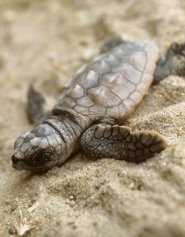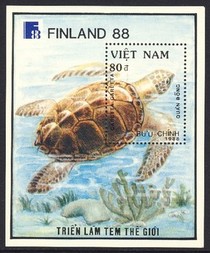Loggerhead Turtle
The Loggerhead Sea Turtle; Male or Female?
 The Loggerhead Sea Turtle (Caretta caretta) has an enormous range. They live in all of the oceans of the world, Atlantic, Pacific, Indian and Mediterranean, except for the most frigid. Loggerheads favor coastal habitats but can have been known to travel far out to sea as well. They spend all of their lives in saltwater or estuarine habitats, except for a short time when the females come to land to lay their eggs. One of the features that distinguish the Loggerhead turtle as unique is the fact that there are no gender differences until the Loggerhead reaches adulthood. Another interesting feature of the Loggerhead turtle is that the female Loggerheads will often travel thousands of miles in order to lay their eggs at the same beach at which they were hatched. They do this with the help of a substance they have in their brains, magnetite (an iron compound), which allows the Loggerhead turtles to feel the magnetic field of the earth.
The Loggerhead Sea Turtle (Caretta caretta) has an enormous range. They live in all of the oceans of the world, Atlantic, Pacific, Indian and Mediterranean, except for the most frigid. Loggerheads favor coastal habitats but can have been known to travel far out to sea as well. They spend all of their lives in saltwater or estuarine habitats, except for a short time when the females come to land to lay their eggs. One of the features that distinguish the Loggerhead turtle as unique is the fact that there are no gender differences until the Loggerhead reaches adulthood. Another interesting feature of the Loggerhead turtle is that the female Loggerheads will often travel thousands of miles in order to lay their eggs at the same beach at which they were hatched. They do this with the help of a substance they have in their brains, magnetite (an iron compound), which allows the Loggerhead turtles to feel the magnetic field of the earth.
The Loggerhead turtle is an omnivorous reptile with a life span of 47-67 years. They range in size from around 31 to 49 inches (around 78 centimeters to 124.5 centimeters) and weigh around 170 to 315 pounds (around 77 kilograms to 142 kilograms). They feed on sea cucumbers, barnacles, crabs, shrimps, horseshoe crabs, sea urchins, conchs, fishes, octopuses, sponges, whelks, star fish, sea anemones, floating egg clusters, insects, flying fish, squids and jellyfish. Although the young have many predators, as do the eggs, once a Loggerhead becomes an adult their size limits their chance of becoming prey except to larger marine life such as sharks, parrotfish, monk seals, moray eels and killer whales.
The population of Loggerheads has declined by over 50% which makes the Loggerhead turtle an endangered species. Declining populations are due to the development of coastlines and beach disturbances by people such as cleaning, artificial lighting (discourages nesting and makes it hard for hatchlings to find their way to the water), fishing, driving and pollution. They are also hunted for food by some cultures as well as for their shells. High speed boat propellers are another killer as is the swallowing of trash such as fishing lines and plastic bags. Another cause of death is when Loggerheads get caught in fishing nets and drown for which the leading killer are shrimp and fish nets.
Conservation groups are trying to implement laws that will save Loggerhead turtles and get them off the endangered list.
The Loggerhead Turtle is classified as Endangered (EN), considered to be facing a very high risk of extinction in the wild.
Common names
Ál-cserepesteknős in Hungarian - Magyar
Caouanne in French - français
Cayuma in Spanish - español
Dikkopschildpad in Dutch - Nederlands
Glavata kareta in Slovenian - slovenščina
logerhead sea turtle in English - English
loggerhead in English - English
loggerhead sea turtle in English - English
Loggerhead Turtle in English - English
Loggerhead Turtle in Ukrainian - українська мова
Oäkta karettsköldpadda in Swedish - Svenska
onechte karetschildpad in Dutch - Nederlands
red sea turtle in English - English
Tartaruga-comum in Portuguese - Português
Tortue caouanne in French - français
Tortuga boba in Spanish - español
Tortuga careta in Catalan - Català
Tortuga-marina caguama in Spanish - español
Unechte Karettschildkröte in German - Deutsch
Карета (костенурка) in Bulgarian - български език
логгерхед in Russian - русский язык
Черепаха атлантическая большеголовая морская in Russian - русский язык
צב ים חום in Hebrew - עברית
لاکپشت سرخ in Persian - فارسی
アオウミガメ属 in Japanese - 日本語
アカウミガメ in Japanese - 日本語
붉은바다거북 in Korean - 한국어

Original source: World Register of Marine Species
Author: Collection Georges Declercq
Permission: Some rights reserved
Family : Cheloniidae
Genus : Caretta
Species : Caretta caretta
Authority : Linnaeus 1758
